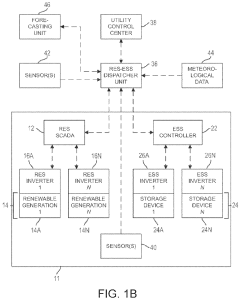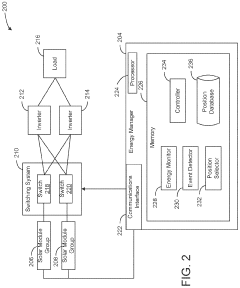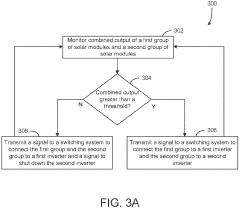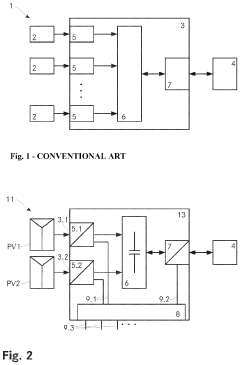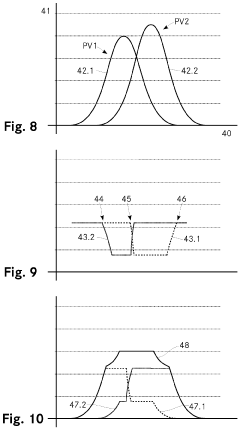Solar Inverter Scalability: The Path Forward
JUL 17, 20259 MIN READ
Generate Your Research Report Instantly with AI Agent
Patsnap Eureka helps you evaluate technical feasibility & market potential.
Solar Inverter Evolution
Solar inverter technology has undergone significant evolution since its inception, driven by the rapid growth of the solar energy industry and the increasing demand for more efficient and reliable power conversion systems. The journey of solar inverters began with simple, centralized designs that were primarily focused on converting DC power from solar panels to AC power for grid connection.
In the early stages, solar inverters were large, centralized units designed to handle the output of entire solar arrays. These early models were characterized by their simplicity but lacked flexibility and efficiency, especially when dealing with partial shading or module mismatch issues. As the solar industry matured, the need for more sophisticated inverter solutions became apparent.
The next significant milestone in solar inverter evolution was the introduction of string inverters. These devices allowed for greater system design flexibility by connecting multiple strings of solar panels to individual inverters. This approach improved overall system efficiency and provided better monitoring capabilities at the string level.
Microinverters emerged as a revolutionary step in solar inverter technology. By attaching a small inverter to each solar panel, microinverters enabled panel-level optimization and monitoring. This innovation significantly improved system performance in challenging conditions such as partial shading and allowed for easier system expansion.
Power optimizers represented another leap forward, combining some of the benefits of microinverters with the cost-effectiveness of string inverters. These devices, installed at the panel level, work in conjunction with a central inverter to optimize power output from each panel individually.
Recent years have seen the development of hybrid inverters, which integrate energy storage capabilities. These advanced systems can manage power flow between solar panels, batteries, and the grid, offering greater energy independence and resilience to grid outages.
The latest trend in solar inverter evolution is the move towards smart, connected inverters. These devices incorporate advanced communication and control features, allowing for better grid integration, remote monitoring, and adaptive power management. Smart inverters play a crucial role in the development of smart grids and the broader energy transition.
As we look towards the future of solar inverter technology, the focus is increasingly on scalability, efficiency, and grid support functions. The industry is exploring ways to enhance power density, improve thermal management, and incorporate advanced semiconductor materials like silicon carbide to push the boundaries of inverter performance and reliability.
In the early stages, solar inverters were large, centralized units designed to handle the output of entire solar arrays. These early models were characterized by their simplicity but lacked flexibility and efficiency, especially when dealing with partial shading or module mismatch issues. As the solar industry matured, the need for more sophisticated inverter solutions became apparent.
The next significant milestone in solar inverter evolution was the introduction of string inverters. These devices allowed for greater system design flexibility by connecting multiple strings of solar panels to individual inverters. This approach improved overall system efficiency and provided better monitoring capabilities at the string level.
Microinverters emerged as a revolutionary step in solar inverter technology. By attaching a small inverter to each solar panel, microinverters enabled panel-level optimization and monitoring. This innovation significantly improved system performance in challenging conditions such as partial shading and allowed for easier system expansion.
Power optimizers represented another leap forward, combining some of the benefits of microinverters with the cost-effectiveness of string inverters. These devices, installed at the panel level, work in conjunction with a central inverter to optimize power output from each panel individually.
Recent years have seen the development of hybrid inverters, which integrate energy storage capabilities. These advanced systems can manage power flow between solar panels, batteries, and the grid, offering greater energy independence and resilience to grid outages.
The latest trend in solar inverter evolution is the move towards smart, connected inverters. These devices incorporate advanced communication and control features, allowing for better grid integration, remote monitoring, and adaptive power management. Smart inverters play a crucial role in the development of smart grids and the broader energy transition.
As we look towards the future of solar inverter technology, the focus is increasingly on scalability, efficiency, and grid support functions. The industry is exploring ways to enhance power density, improve thermal management, and incorporate advanced semiconductor materials like silicon carbide to push the boundaries of inverter performance and reliability.
Market Demand Analysis
The global solar inverter market is experiencing robust growth, driven by the increasing adoption of solar energy systems across residential, commercial, and utility-scale applications. As the world transitions towards renewable energy sources, the demand for more efficient and scalable solar inverter solutions continues to rise.
The market for solar inverters is closely tied to the overall growth of the solar photovoltaic (PV) industry. According to recent industry reports, the global solar PV market is expected to grow at a compound annual growth rate (CAGR) of over 20% in the coming years. This growth is primarily fueled by declining solar panel costs, government incentives, and increasing environmental awareness.
In the residential sector, there is a growing trend towards smart home integration and energy management systems. Homeowners are seeking solar inverter solutions that can seamlessly connect with their home automation systems, allowing for better control and optimization of energy consumption. This trend is driving demand for inverters with advanced communication capabilities and user-friendly interfaces.
Commercial and industrial sectors are increasingly adopting solar energy to reduce operational costs and meet sustainability goals. These sectors require scalable inverter solutions that can handle larger power capacities and offer features such as remote monitoring and predictive maintenance. The ability to easily expand existing solar installations is becoming a key consideration for businesses looking to gradually increase their renewable energy capacity.
Utility-scale solar projects are witnessing significant growth worldwide, particularly in regions with favorable solar resources and supportive policies. These large-scale installations demand highly efficient and reliable inverter systems that can maximize energy yield and minimize downtime. The market is seeing increased demand for central inverters and string inverters optimized for utility-scale applications.
Energy storage integration is emerging as a critical factor in the solar inverter market. As battery technology advances and becomes more affordable, there is growing interest in hybrid inverter systems that can seamlessly manage both solar generation and energy storage. This trend is driven by the need for grid stability, energy independence, and the ability to optimize self-consumption of solar energy.
The push for higher efficiency and power density in solar inverters is another key market driver. Manufacturers are focusing on developing inverters with higher power ratings and improved thermal management to reduce overall system costs and improve energy yield. This trend is particularly important for large-scale installations where even small improvements in efficiency can translate to significant energy and cost savings.
Geographically, Asia-Pacific is expected to dominate the solar inverter market, with China and India leading the growth. Europe and North America are also significant markets, driven by supportive renewable energy policies and increasing corporate commitments to sustainability. Emerging markets in Africa and Latin America are showing promising growth potential as they invest in expanding their renewable energy infrastructure.
The market for solar inverters is closely tied to the overall growth of the solar photovoltaic (PV) industry. According to recent industry reports, the global solar PV market is expected to grow at a compound annual growth rate (CAGR) of over 20% in the coming years. This growth is primarily fueled by declining solar panel costs, government incentives, and increasing environmental awareness.
In the residential sector, there is a growing trend towards smart home integration and energy management systems. Homeowners are seeking solar inverter solutions that can seamlessly connect with their home automation systems, allowing for better control and optimization of energy consumption. This trend is driving demand for inverters with advanced communication capabilities and user-friendly interfaces.
Commercial and industrial sectors are increasingly adopting solar energy to reduce operational costs and meet sustainability goals. These sectors require scalable inverter solutions that can handle larger power capacities and offer features such as remote monitoring and predictive maintenance. The ability to easily expand existing solar installations is becoming a key consideration for businesses looking to gradually increase their renewable energy capacity.
Utility-scale solar projects are witnessing significant growth worldwide, particularly in regions with favorable solar resources and supportive policies. These large-scale installations demand highly efficient and reliable inverter systems that can maximize energy yield and minimize downtime. The market is seeing increased demand for central inverters and string inverters optimized for utility-scale applications.
Energy storage integration is emerging as a critical factor in the solar inverter market. As battery technology advances and becomes more affordable, there is growing interest in hybrid inverter systems that can seamlessly manage both solar generation and energy storage. This trend is driven by the need for grid stability, energy independence, and the ability to optimize self-consumption of solar energy.
The push for higher efficiency and power density in solar inverters is another key market driver. Manufacturers are focusing on developing inverters with higher power ratings and improved thermal management to reduce overall system costs and improve energy yield. This trend is particularly important for large-scale installations where even small improvements in efficiency can translate to significant energy and cost savings.
Geographically, Asia-Pacific is expected to dominate the solar inverter market, with China and India leading the growth. Europe and North America are also significant markets, driven by supportive renewable energy policies and increasing corporate commitments to sustainability. Emerging markets in Africa and Latin America are showing promising growth potential as they invest in expanding their renewable energy infrastructure.
Technical Challenges
Solar inverter scalability faces several significant technical challenges that need to be addressed to ensure the continued growth and efficiency of solar energy systems. One of the primary obstacles is the integration of high-power inverters with existing grid infrastructure. As solar installations grow in size and capacity, the demand for inverters capable of handling higher power outputs increases. However, connecting these high-power inverters to the grid often requires substantial upgrades to transmission and distribution systems, which can be costly and time-consuming.
Another critical challenge lies in the development of advanced control algorithms for large-scale inverter systems. As the number of inverters in a solar farm increases, maintaining stable operation and optimal power flow becomes increasingly complex. Current control strategies may struggle to effectively manage the interactions between multiple inverters and the grid, potentially leading to instability issues and reduced overall system efficiency.
The reliability and longevity of inverter components present another significant hurdle. As inverters are scaled up to handle higher power outputs, the stress on individual components increases. This can lead to accelerated wear and tear, potentially reducing the lifespan of the inverter and increasing maintenance costs. Developing more robust and durable components that can withstand the demands of high-power operation is crucial for improving the scalability of solar inverters.
Thermal management is a persistent challenge in solar inverter scalability. As power density increases, so does the heat generated by the inverter components. Efficient cooling systems are essential to maintain optimal performance and prevent premature component failure. However, designing effective cooling solutions for high-power inverters while keeping costs and complexity in check remains a significant technical challenge.
The need for improved energy storage integration also poses a challenge for solar inverter scalability. As solar installations grow larger, the ability to effectively store and dispatch energy becomes increasingly important for grid stability and maximizing the value of solar generation. Developing inverter technologies that can seamlessly interface with various energy storage systems and optimize their operation is a complex task that requires further innovation.
Lastly, the challenge of harmonics and power quality management becomes more pronounced as solar inverter systems scale up. Large-scale inverter installations can introduce significant harmonic distortions into the grid, potentially affecting power quality and violating grid codes. Developing advanced filtering and control techniques to mitigate these issues while maintaining high efficiency is a critical area of ongoing research and development in the field of solar inverter technology.
Another critical challenge lies in the development of advanced control algorithms for large-scale inverter systems. As the number of inverters in a solar farm increases, maintaining stable operation and optimal power flow becomes increasingly complex. Current control strategies may struggle to effectively manage the interactions between multiple inverters and the grid, potentially leading to instability issues and reduced overall system efficiency.
The reliability and longevity of inverter components present another significant hurdle. As inverters are scaled up to handle higher power outputs, the stress on individual components increases. This can lead to accelerated wear and tear, potentially reducing the lifespan of the inverter and increasing maintenance costs. Developing more robust and durable components that can withstand the demands of high-power operation is crucial for improving the scalability of solar inverters.
Thermal management is a persistent challenge in solar inverter scalability. As power density increases, so does the heat generated by the inverter components. Efficient cooling systems are essential to maintain optimal performance and prevent premature component failure. However, designing effective cooling solutions for high-power inverters while keeping costs and complexity in check remains a significant technical challenge.
The need for improved energy storage integration also poses a challenge for solar inverter scalability. As solar installations grow larger, the ability to effectively store and dispatch energy becomes increasingly important for grid stability and maximizing the value of solar generation. Developing inverter technologies that can seamlessly interface with various energy storage systems and optimize their operation is a complex task that requires further innovation.
Lastly, the challenge of harmonics and power quality management becomes more pronounced as solar inverter systems scale up. Large-scale inverter installations can introduce significant harmonic distortions into the grid, potentially affecting power quality and violating grid codes. Developing advanced filtering and control techniques to mitigate these issues while maintaining high efficiency is a critical area of ongoing research and development in the field of solar inverter technology.
Current Scalability Solutions
01 Modular and scalable inverter systems
Solar inverter systems can be designed with modular architecture, allowing for easy scalability. These systems can be expanded by adding or removing inverter modules as needed, providing flexibility to accommodate varying power requirements and system sizes. This approach enables efficient scaling of solar power installations without major redesigns.- Modular design for scalability: Solar inverter systems can be designed with modular components, allowing for easy expansion and scalability. This approach enables the addition of new inverter units or modules to increase power capacity as needed, without requiring a complete system overhaul. Modular designs also facilitate maintenance and upgrades, improving overall system flexibility and longevity.
- Parallel operation of multiple inverters: Multiple solar inverters can be connected in parallel to increase the overall power output and system capacity. This configuration allows for load sharing, improved efficiency, and enhanced reliability. Parallel operation also provides redundancy, ensuring continued operation even if one inverter fails, and enables easier system expansion to meet growing energy demands.
- Smart grid integration and communication: Solar inverters can be designed with advanced communication capabilities to integrate seamlessly with smart grid systems. This allows for better monitoring, control, and optimization of power flow between the solar array, the grid, and local loads. Smart grid integration enables scalability by facilitating the coordination of multiple inverters and optimizing overall system performance.
- Adaptive control algorithms: Implementing adaptive control algorithms in solar inverters can enhance their scalability and performance. These algorithms can automatically adjust inverter parameters based on changing environmental conditions, load demands, and system configurations. This adaptability allows the inverter system to maintain optimal efficiency and power quality across a wide range of operating conditions and system sizes.
- Energy storage integration: Incorporating energy storage systems, such as batteries, into solar inverter designs can improve scalability and system flexibility. This integration allows for better management of power fluctuations, load balancing, and grid support. Energy storage can also enable the expansion of solar capacity without overloading the grid during peak production periods, facilitating easier system scaling.
02 Parallel operation of multiple inverters
Multiple solar inverters can be connected in parallel to increase the overall power output and system capacity. This configuration allows for load sharing and improved reliability through redundancy. Parallel operation enables seamless scaling of solar power systems to meet growing energy demands.Expand Specific Solutions03 Adaptive control and power management
Advanced control algorithms and power management techniques can be implemented in solar inverters to optimize performance and efficiency across various scales. These systems can dynamically adjust to changing environmental conditions, load demands, and system configurations, ensuring optimal operation regardless of system size.Expand Specific Solutions04 Grid integration and smart inverter functionality
Solar inverters can be designed with advanced grid integration capabilities and smart functionalities to support scalability. These features include voltage and frequency regulation, reactive power control, and communication interfaces for grid coordination. Such capabilities enable seamless integration of large-scale solar installations into the power grid.Expand Specific Solutions05 Scalable energy storage integration
Solar inverter systems can be designed to integrate with scalable energy storage solutions, such as battery banks. This integration allows for improved energy management, load balancing, and grid support capabilities. The combination of scalable inverters and energy storage enables the creation of flexible and resilient solar power systems that can adapt to various scales and applications.Expand Specific Solutions
Key Industry Players
The solar inverter scalability market is in a growth phase, driven by increasing demand for renewable energy solutions. The market size is expanding rapidly, with key players like SMA Solar Technology AG, Tesla, Inc., and Huawei Digital Power Technologies Co Ltd leading innovation. These companies are developing advanced technologies to improve efficiency and scalability of solar inverters. The technology is maturing, with established firms like Siemens AG and emerging players such as Ampt LLC pushing boundaries in power conversion and optimization. As the industry evolves, we're seeing a trend towards more integrated and intelligent inverter systems, capable of managing larger-scale solar installations and grid integration challenges.
SMA Solar Technology AG
Technical Solution: SMA Solar Technology AG has developed a scalable solar inverter solution called the Sunny Central UP. This inverter is designed for utility-scale PV power plants and offers a power range of up to 4.6 MW. The Sunny Central UP utilizes advanced power electronics and modular design to enhance scalability. It features a flexible DC:AC ratio of up to 1.5, allowing for optimal system design and increased energy yield[1]. The inverter incorporates SMA's Virtual Central Inverter technology, which enables parallel operation of multiple units, simplifying system expansion and maintenance[2]. Additionally, SMA has implemented advanced grid management functions and smart monitoring capabilities to ensure grid stability and optimize performance in large-scale installations[3].
Strengths: High power capacity, modular design for easy scalability, advanced grid management features. Weaknesses: May be less cost-effective for smaller installations, potential complexity in system integration for some users.
Tesla, Inc.
Technical Solution: Tesla's approach to solar inverter scalability focuses on their Powerwall and Solar Roof products. The company has developed a proprietary inverter technology that integrates seamlessly with their energy storage systems. Tesla's inverters utilize advanced power electronics and machine learning algorithms to optimize energy conversion and storage. The scalability is achieved through a modular design that allows multiple Powerwall units to be connected in parallel, increasing overall system capacity[1]. Tesla's inverters also feature built-in communication capabilities, enabling real-time monitoring and over-the-air updates for improved performance and functionality[2]. The company has implemented a unique "Virtual Power Plant" concept, where multiple residential solar and storage systems can be aggregated and controlled as a single, large-scale power source, enhancing grid stability and scalability[3].
Strengths: Seamless integration with energy storage, advanced control algorithms, scalable through modular design. Weaknesses: Limited compatibility with non-Tesla solar products, potentially higher costs compared to standalone inverters.
Innovative Inverter Designs
Systems and methods for optimizing loading of solar inverters
PatentActiveUS11841725B1
Innovation
- A dynamic switching system controlled by a processor that connects different solar module groups with inverters based on power output, shutting off unused inverters and optimizing power distribution to maintain full load operations and reduce no-load losses.
Control of a multiple input solar power inverter
PatentActiveUS10523014B2
Innovation
- A method for controlling a solar power inverter with multiple photovoltaic inputs, involving the identification and prioritization of PV inputs based on characteristics like output voltage or temperature, and limiting input power to enhance efficiency by calculating and applying a set value for the DC-DC converters, ensuring operation at or below the maximum power capacity of each PV module.
Grid Integration Strategies
Grid integration strategies play a crucial role in addressing the challenges of solar inverter scalability. As the penetration of solar energy increases, the need for effective integration with the existing power grid becomes paramount. One key strategy involves the implementation of advanced control systems that enable seamless communication between solar inverters and grid operators. These systems allow for real-time monitoring and adjustment of power output, ensuring grid stability and reliability.
Another important aspect of grid integration is the development of smart grid technologies. These technologies facilitate bidirectional power flow, allowing solar inverters to not only supply electricity to the grid but also respond to grid demands. This flexibility enhances the overall efficiency of the power system and helps balance supply and demand more effectively.
The adoption of energy storage systems is also a critical component of grid integration strategies. By incorporating battery storage alongside solar inverters, excess energy can be stored during peak production periods and released when demand is high or solar generation is low. This approach helps mitigate the intermittency issues associated with solar power and provides a more stable and reliable energy supply.
Standardization efforts are essential for improving the interoperability of solar inverters with different grid infrastructures. The development and implementation of universal communication protocols and grid codes ensure that solar inverters can seamlessly integrate with various grid systems across different regions and countries.
Grid operators are also exploring the use of virtual power plants (VPPs) as a means of integrating distributed solar resources. VPPs aggregate multiple solar installations and other renewable energy sources, managing them as a single entity. This approach allows for more efficient coordination of distributed energy resources and provides greater flexibility in grid management.
The implementation of advanced forecasting techniques is another crucial strategy for grid integration. Accurate predictions of solar power generation help grid operators better plan and manage the integration of solar energy into the grid. These forecasting models take into account various factors such as weather patterns, historical data, and real-time sensor information to optimize grid operations.
As solar inverter technology continues to evolve, grid integration strategies must adapt to accommodate higher power capacities and more sophisticated functionalities. This includes the development of inverters with enhanced grid support features, such as reactive power control and voltage regulation capabilities, which contribute to overall grid stability and power quality.
Another important aspect of grid integration is the development of smart grid technologies. These technologies facilitate bidirectional power flow, allowing solar inverters to not only supply electricity to the grid but also respond to grid demands. This flexibility enhances the overall efficiency of the power system and helps balance supply and demand more effectively.
The adoption of energy storage systems is also a critical component of grid integration strategies. By incorporating battery storage alongside solar inverters, excess energy can be stored during peak production periods and released when demand is high or solar generation is low. This approach helps mitigate the intermittency issues associated with solar power and provides a more stable and reliable energy supply.
Standardization efforts are essential for improving the interoperability of solar inverters with different grid infrastructures. The development and implementation of universal communication protocols and grid codes ensure that solar inverters can seamlessly integrate with various grid systems across different regions and countries.
Grid operators are also exploring the use of virtual power plants (VPPs) as a means of integrating distributed solar resources. VPPs aggregate multiple solar installations and other renewable energy sources, managing them as a single entity. This approach allows for more efficient coordination of distributed energy resources and provides greater flexibility in grid management.
The implementation of advanced forecasting techniques is another crucial strategy for grid integration. Accurate predictions of solar power generation help grid operators better plan and manage the integration of solar energy into the grid. These forecasting models take into account various factors such as weather patterns, historical data, and real-time sensor information to optimize grid operations.
As solar inverter technology continues to evolve, grid integration strategies must adapt to accommodate higher power capacities and more sophisticated functionalities. This includes the development of inverters with enhanced grid support features, such as reactive power control and voltage regulation capabilities, which contribute to overall grid stability and power quality.
Energy Storage Synergies
The integration of energy storage systems with solar inverters represents a significant advancement in the scalability and efficiency of solar power generation. This synergy addresses several key challenges in renewable energy deployment, particularly the intermittency of solar power and grid stability issues.
Energy storage systems, when coupled with solar inverters, enable a more consistent and reliable power output. During peak sunlight hours, excess energy can be stored for use during periods of low solar generation or high demand. This capability not only enhances the overall system efficiency but also provides grid operators with greater flexibility in managing power distribution.
The scalability of solar inverters is significantly improved through energy storage integration. As solar installations grow in size and complexity, the ability to store and dispatch energy on demand becomes crucial. This allows for better load balancing and peak shaving, reducing strain on the grid infrastructure and potentially deferring costly grid upgrades.
Advanced battery technologies, such as lithium-ion and flow batteries, are at the forefront of this synergy. These storage solutions offer high energy density, rapid response times, and increasingly longer lifespans, making them ideal companions for solar inverters. The continuous improvements in battery chemistry and management systems are driving down costs and improving the economic viability of integrated solar-plus-storage systems.
Smart inverter technologies are evolving to seamlessly incorporate energy storage capabilities. These intelligent systems can optimize power flow between the solar array, battery, and grid, maximizing self-consumption and providing ancillary services to the grid. Features such as frequency regulation, voltage support, and reactive power control are becoming standard in advanced inverter-storage systems.
The regulatory landscape is also adapting to support this integration. Many jurisdictions are implementing policies and incentives that recognize the value of combined solar and storage systems, encouraging their adoption and deployment at both residential and utility scales.
Looking ahead, the synergy between solar inverters and energy storage is expected to play a pivotal role in the transition to a more resilient and sustainable energy infrastructure. As technology continues to advance, we can anticipate further innovations in areas such as bidirectional power flow, virtual power plants, and AI-driven energy management systems, all of which will leverage the combined strengths of solar generation and energy storage.
Energy storage systems, when coupled with solar inverters, enable a more consistent and reliable power output. During peak sunlight hours, excess energy can be stored for use during periods of low solar generation or high demand. This capability not only enhances the overall system efficiency but also provides grid operators with greater flexibility in managing power distribution.
The scalability of solar inverters is significantly improved through energy storage integration. As solar installations grow in size and complexity, the ability to store and dispatch energy on demand becomes crucial. This allows for better load balancing and peak shaving, reducing strain on the grid infrastructure and potentially deferring costly grid upgrades.
Advanced battery technologies, such as lithium-ion and flow batteries, are at the forefront of this synergy. These storage solutions offer high energy density, rapid response times, and increasingly longer lifespans, making them ideal companions for solar inverters. The continuous improvements in battery chemistry and management systems are driving down costs and improving the economic viability of integrated solar-plus-storage systems.
Smart inverter technologies are evolving to seamlessly incorporate energy storage capabilities. These intelligent systems can optimize power flow between the solar array, battery, and grid, maximizing self-consumption and providing ancillary services to the grid. Features such as frequency regulation, voltage support, and reactive power control are becoming standard in advanced inverter-storage systems.
The regulatory landscape is also adapting to support this integration. Many jurisdictions are implementing policies and incentives that recognize the value of combined solar and storage systems, encouraging their adoption and deployment at both residential and utility scales.
Looking ahead, the synergy between solar inverters and energy storage is expected to play a pivotal role in the transition to a more resilient and sustainable energy infrastructure. As technology continues to advance, we can anticipate further innovations in areas such as bidirectional power flow, virtual power plants, and AI-driven energy management systems, all of which will leverage the combined strengths of solar generation and energy storage.
Unlock deeper insights with Patsnap Eureka Quick Research — get a full tech report to explore trends and direct your research. Try now!
Generate Your Research Report Instantly with AI Agent
Supercharge your innovation with Patsnap Eureka AI Agent Platform!

